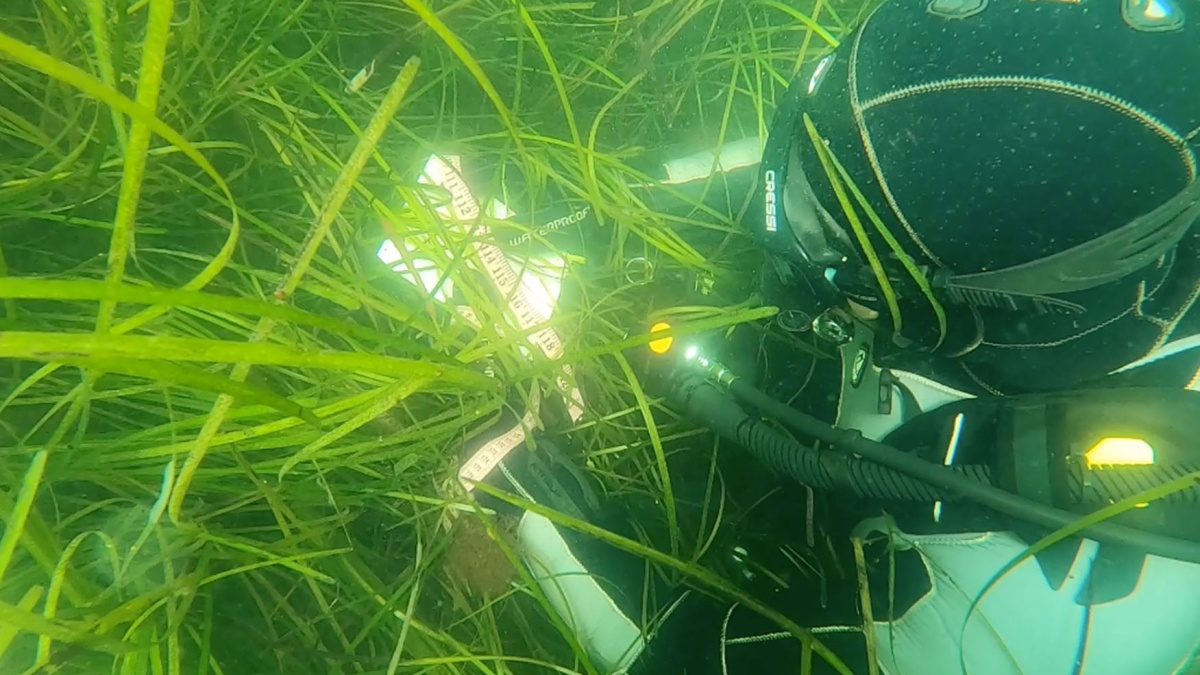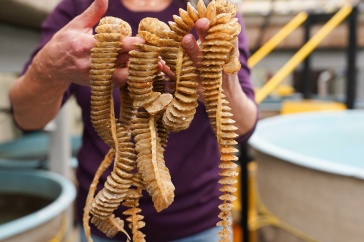Meet Marine Biologist Grant Milne
Key Finding:
Using a combination of passive acoustic monitoring and metabarcoding seawater samples, researchers with the UNH College of Life Sciences and Agriculture and the UNH Center for Acoustics Research & Education assessed the ecological connectivity of three coastal marine habitats in the Gulf of Maine. The scientists found that the combined method offered a more wholistic picture of biological connectivity in terms of ecology and function.
Key Terms:
Ecological (or biological) connectivity: Expand for definition
Refers to the movement of organisms among different habitats or areas that can influence population dynamics, genetic diversity and ecosystem functioning.
Functional connectivity: Expand for definition
Refers to the ecological processes that occur among different habitats or areas that can influence ecosystem productivity, nutrient cycling and other aspects of ecosystem functioning. Functional connectivity can be influenced by physical factors such as water flow, as well as biological factors such as the movement of organisms that play important roles in ecosystem processes.
Metagenomics: Expand for definition
A field of study that uses DNA sequencing technology to identify and analyze the genetic material (e.g., DNA) from a mixture of organisms (e.g., bacteria, fungi and viruses) in environmental samples such as soil, water or air. This approach allows scientists to study the diversity and function of entire communities in their natural environments.
Metabarcoding: Expand for definition
A method used in metagenomics that targets specific DNA markers (i.e., DNA sequences that are unique to a particular group of organisms) to identify the organisms present in a sample. By comparing the DNA sequences obtained from a sample to a reference database, scientists can identify the different species present in a sample and estimate their abundance.
Metabarcoding Seawater Samples (MSS): Expand for definition
A technique used to identify the genetic material from different types of organisms present in a sample of seawater.
Passive Acoustic Monitoring (PAM): Expand for definition
A technique used to monitor sounds in natural environments (e.g., oceans, forests) without disturbing the organisms being studied. This involves deploying underwater hydrophones or terrestrial microphones to capture sounds made by the environment (e.g., wind, waves, ice rain) and organisms (e.g., whales, birds, insects). Analyzing signals in the recordings provide insight on animal behavior, communication and ecology.
Spatiotemporal scales: Expand for definition
A way of describing the scope and duration of a study in terms of space and time. Spatial scales refer to the area or extent of a study (e.g., local, regional, global), whereas temporal scales refer to the duration or frequency of a study (e.g., seconds, minutes, hours, days, years, decades). Understanding spatiotemporal scales is important in ecology because it helps scientists determine the appropriate methods and tools to use for their study and interpret their results in a meaningful way.
Soundscape: Expand for definition
"Characterization of the ambient sound in terms of its spatial, temporal and frequency attributes, and the types of sources contributing to the sound field.” ISO 18405
Soundscape ecology: Expand for definition
The study of acoustic relationships that exist among organisms (including humans) and their environments.
For the past two summers, marine biology doctoral student Grant Milne spent several days a week off the coasts of New Castle, N.H., and Fort Foster, Maine collecting sound and water samples. Donning scuba gear, deploying hydrophones (underwater microphones) and carrying water sampling containers, Milne recorded the soundscapes via a methodology called Passive Acoustic Monitoring, or PAM, in three habitat types to better understand the connectivity of these potentially at-risk Gulf of Maine areas—as well as investigate how natural or human change would impact their soundscapes. Milne’s research and research like it occurring at the UNH College of Life Sciences and Agriculture (COLSA) represent an emerging, non-destructive approach to studying natural environments and conservation ecology—by comparing soundscapes and genetic makeup, and tracking them over time, to assess anthropogenic impacts and other causes of environmental change.
“The ability to assess the acoustic environment through minimally invasive monitoring techniques is valuable for managing marine ecosystems, particularly in terms of the impacts of human-caused noise,” described Milne. “Additionally, observation of biological and acoustic connectivity between habitats is valuable for assessing indirect impacts to surrounding habitats’ soundscapes, especially when the soundscape of one habitat experiences natural or human caused change.”
Recently, Milne published findings of his research in an issue of Oceanography. Milne, who served as the lead author on the paper, is a student in the lab of Bonnie Brown, professor and chair of the department of biological sciences, and Jennifer Miksis-Olds, director of the UNH Center for Acoustics Research and Education. Milne has pursued his interest in metagenomics—the study of genetic materials found within a sample taken from the environment— in Brown’s Ecological Genetics Lab.
“My study looked at three particular coastal marine habitats: common eelgrass (Zostera marina) in soft seabeds made up of sand and mud, macroalgae colonies located on hard seabeds made up of gravel beds and boulders, and soft seabeds without eelgrass,” said Milne. “My colleagues and I would visit our sampling sites a few times per week, then take our samples back to the lab to categorize and sequence them.”
In the acoustics research lab of Miksis-Olds, Milne analyzed the sounds using a “Soundscape Code” developed by co-author Dylan Wilford ’21G. The code helped compare the soundscapes of different habitats and geographic regions and allowed the scientists to determine whether there are significant relationships or differences among the soundscapes of the three habitats.
Diving in Gulf of Maine with Grant Milne
“Grant’s work is progressive in that the combination of acoustics and genomics provides more information about the environment together than either sensing method does alone,” explained Miksis-Olds. “PAM only provides information on animals or sources generating sound (silent animals or sources go undetected). With genomic information, it is possible to learn about what animals are present in an ecosystem but silent.”


In Brown’s ecological genetics lab, Milne isolated organic matter found in the water samples and sequenced the DNA to determine which plants and animals were present. To do this, he used a method called metabarcoding seawater samples (MSS), which amplifies and then sequences the genetic material from various organisms found in a single sample of seawater and compares the DNA to a database to determine from which organisms the DNA was derived.
“Metagenomics allows us to detect living members of communities without actually capturing the species—instead using microbes, poo or sloughed cells left behind by transient species, or whole or parts of organisms that washed into the water from the land, for example,” said Brown. “Grant’s work to combine MSS with PAM is pushing the envelope of non-destructive environmental sampling.”
“This project initially interested me for the work involving ecological genetics, which I studied as an undergraduate,” added Milne. “However, during this research, I also grew to appreciate the power of acoustics as a tool for monitoring and managing ecosystems and continue to realize the research opportunities in this field.”
This material is based on work supported by the UNH Center for Acoustics Research and Education (CARE) through funding from the Office of Naval Research Award N00014-19-1-2515 to J. Miksis-Olds. Milne is also funded by COLSA. This work is co-authored by Grant Milne, Jennifer Miksis-Olds, Alyssa Stasse, Bo-Young Lee, Dylan Wilford and Bonnie Brown.
You can read the published article, Evaluating Connectivity of Coastal Marine Habitats in the Gulf of Maine by Integrating Passive Acoustics and Metabarcoding, in Oceanography.
-
Written By:
Nicholas Gosling '06 | COLSA/NH Agricultural Experiment Station | nicholas.gosling@unh.edu

















































